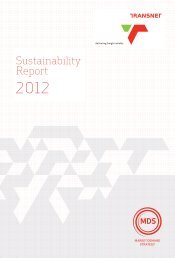Noise and Vibration Report - Transnet
Noise and Vibration Report - Transnet
Noise and Vibration Report - Transnet
- No tags were found...
Create successful ePaper yourself
Turn your PDF publications into a flip-book with our unique Google optimized e-Paper software.
ENVIRO-ACOUSTIC RESEARCHSCOPING NOISE REPORT – TRANSNET: SWAZI RAIL LINK – DAVEL YARD TO NERSTON RSA ROUTEThe recommendations that the st<strong>and</strong>ards make are likely to inform decisions by authorities,but non-compliance with the st<strong>and</strong>ards will not necessarily render an activity unlawful per se.SANS however have no specific st<strong>and</strong>ards dealing with noise emission from rail traffic.2.6 INTERNATIONAL GUIDELINES – NOISE CONTROLWhile there exist a number of international guidelines <strong>and</strong> st<strong>and</strong>ards that could encompass adocument in itself, the reports mentioned below were selected as they are used by differentcountries in the subject of environmental noise management.2.6.1 Guidelines for Community <strong>Noise</strong> (WHO, 1999)The World Health Organization’s (WHO) document on the Guidelines for Community <strong>Noise</strong> isthe outcome of the WHO- expert task force meeting held in London, United Kingdom, in April1999. It is based on the document entitled “Community <strong>Noise</strong>” that was prepared for theWorld Health Organization <strong>and</strong> published in 1995 by the Stockholm University <strong>and</strong> KarolinskaInstitute.The scope of WHO's effort to derive guidelines for community noise is to consolidate actualscientific knowledge on the health impacts of community noise <strong>and</strong> to provide guidance toenvironmental health authorities <strong>and</strong> professionals trying to protect people from the harmfuleffects of noise in non-industrial environments.Guidance on the health effects of noise exposure of the population has already been given inan early publication of the series of Environmental Health Criteria. The health risk to humansfrom exposure to environmental noise was evaluated <strong>and</strong> guidelines values derived. The issueof noise control <strong>and</strong> health protection was briefly addressed.The document uses the L Aeq <strong>and</strong> L A,max descriptors to define noise levels. This document wasimportant in the development of the SANS 10103 st<strong>and</strong>ard.2.6.2 Night <strong>Noise</strong> Guidelines for Europe (WHO, 2009)Refining previous Community <strong>Noise</strong> Guidelines issued in 1999, <strong>and</strong> incorporating more recentresearch, the World Health Organization has released a comprehensive report on the healtheffects of night time noise, along with new (non-m<strong>and</strong>atory) guidelines for use inEurope. Rather than a maximum of 30 dB inside at night (which equals 45-50 dB maxinside), the WHO now recommends a maximum year-round outside night-time noise averageof 40 db to avoid sleep disturbance <strong>and</strong> its related health effects. The report notes that onlybelow 30 dB (outside annual average) are “no significant biological effects observed,” <strong>and</strong>P a g e | 12
















